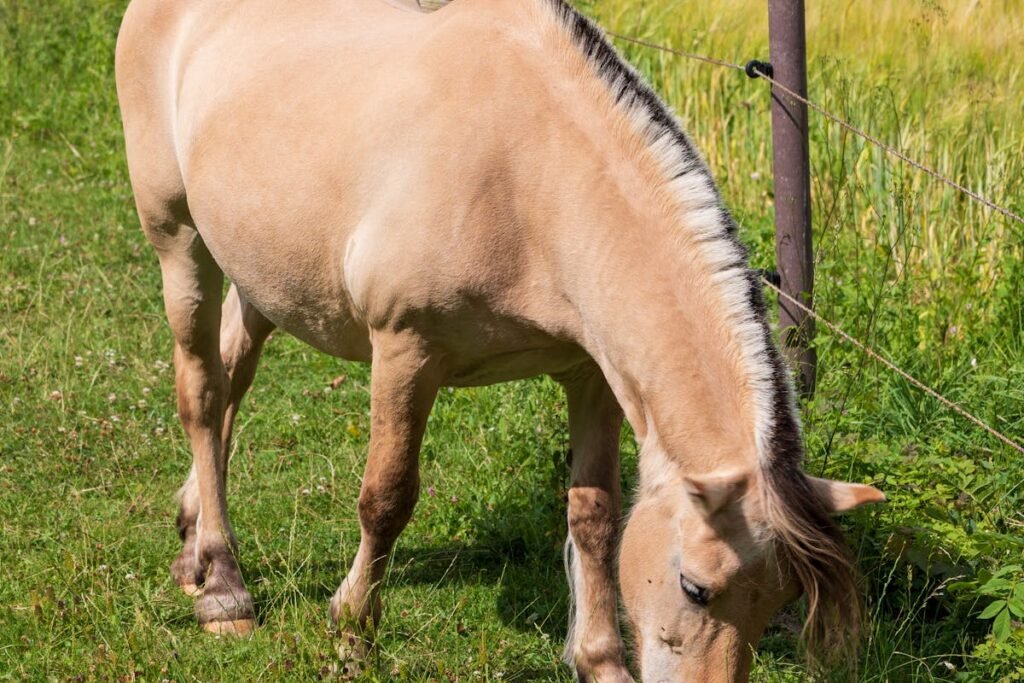The American Cream Horse stands out not just for its stunning golden coat and amber eyes, but for its rarity and near-extinction status. As the only draft horse breed developed in the United States, it carries cultural and agricultural significance. However, a combination of modern industrial practices, dwindling interest in draft breeds, and genetic limitations has placed it on the critically endangered list.
The phrase “American Cream Horse what’s causing this to endanger” triggers an emotional response among animal lovers and agricultural historians alike. It asks us to consider how such a majestic creature, once a staple on American farms, could be teetering on the edge of extinction. This situation reflects broader issues—changing agricultural practices, modern breeding preferences, and cultural forgetfulness.
The Unique Beauty of the American Cream Horse
The American Cream Horse, with its striking cream-colored coat, pink skin, and captivating amber eyes, is a living piece of art. Unlike albinos, these horses exhibit a champagne gene that gives them their distinct appearance. They carry a gentle expression, solid frame, and easy temperament that make them not only beautiful but practical. Their look sets them apart from other draft horses, making them easily recognizable and deeply admired.
Historical Origins
The breed traces back to the early 20th century in Iowa, beginning with a mare named “Old Granny.” Her lineage produced consistently cream-colored foals with exceptional strength and disposition. Farmers began selecting for these traits, and by the 1930s, the American Cream Draft Horse Association was formed to preserve and promote the breed. This regional marvel became a symbol of American agricultural resilience.
Recognition and Registry
In 1944, the breed was officially recognized by the Iowa Department of Agriculture, marking a crucial moment in its history. However, this recognition came during a time when the agricultural industry was rapidly evolving. Despite having a registry and dedicated breeders, the American Cream Horse couldn’t compete with mechanized farming and larger draft breeds imported from Europe.
Characteristics of the Breed
These horses weigh between 1,600 and 2,000 pounds and stand 15-16 hands tall. They’re strong but not overly bulky, making them ideal for light to moderate farm work. Calm, trainable, and affectionate, they’ve long been trusted by families and farmers. What’s more, their unique color and calm demeanor make them perfect for parades, ceremonies, and educational programs.
Population Decline
In recent years, the population of registered American Cream Horses has dropped to fewer than 500, classifying them as critically endangered. Their numbers were much higher in the mid-20th century, but societal changes led to dramatic decreases. Unlike other livestock, horses are not raised for meat in the U.S., so economic drivers for maintaining such breeds have faded.
Role in Agriculture
American Cream Horses once played a vital role in plowing fields, pulling wagons, and managing everyday farm work. In pre-tractor America, these horses were indispensable. Their strength and temperament suited family farms. But today, that role has diminished almost entirely, contributing to the breed’s decline.
The Rise of Mechanization
With the industrial boom came the mechanization of farming. Tractors and machinery replaced horses at an alarming rate. Draft horses, once the backbone of agriculture, were suddenly obsolete. The American Cream Horse, less known than other draft breeds, was hit especially hard. Mechanization is perhaps the most significant factor behind the breed’s endangered status.
Loss of Traditional Farming
As small family farms dwindled, so too did the demand for draft horses. Corporate agriculture, driven by efficiency and scale, eliminated the need for these gentle giants. The American Cream Horse, bred specifically for small-scale, sustainable farming, lost its niche.
Breeding Challenges
With a limited genetic pool, the breed faces unique challenges. Responsible breeders must avoid inbreeding while trying to preserve desired traits. This delicate balance requires planning, resources, and sometimes heartbreak when foals are lost due to genetic incompatibilities or defects.
Genetic Health Concerns
One significant issue is the presence of a recessive gene that causes Junctional Epidermolysis Bullosa (JEB), a fatal skin condition in foals. While genetic testing helps avoid carrier pairings, it complicates breeding efforts and narrows options further, slowing the breed’s recovery.
Lack of Public Awareness
Unlike Friesians or Clydesdales, the American Cream Horse doesn’t enjoy mainstream popularity. The lack of exposure makes it harder to attract breeders or financial support. Education and public relations are vital to reversing this trend.
Economic Factors
Raising any draft horse is expensive. Feed, space, and veterinary care all add up. When there’s no clear economic return, few people are willing to take on the responsibility. This cost barrier discourages potential breeders and owners, further shrinking the breed’s base.
Competition from Other Breeds
Established European draft breeds dominate the market and cultural consciousness. Clydesdales, with their flashy feathers and Budweiser fame, outshine the humble American Cream. Even other U.S. breeds like the Belgian and Percheron are more populous, sidelining the Cream.
Impact of Urbanization
Urban sprawl has reduced the availability of pastureland and barns. Hobby farmers and horse lovers find it harder to maintain large animals. As cities expand, the space needed for breeds like the American Cream Horse disappears.
Cultural Shifts in Livestock Use
The horse has transitioned from a work animal to a hobby or sport companion. This shift, while beneficial for some breeds, has left workhorses like the American Cream out of favor. Unless their narrative is re-framed, they’ll remain in obscurity.
Preservation Efforts
The Livestock Conservancy lists the breed as critically endangered and supports conservation efforts. Dedicated breeders, mainly in the Midwest, are working tirelessly to rebuild numbers. These efforts include careful lineage tracking and participation in public education.
Role of Horse Lovers and Enthusiasts
Enthusiasts play a massive role in preserving the breed. By attending breed expos, spreading awareness online, and even sponsoring animals, they help the American Cream Horse stay visible. Grassroots efforts often prove the most resilient.
Conservation Programs
Grants, cooperative breeding programs, and public-private partnerships can help. Government involvement, especially from agriculture and heritage departments, could offer financial and policy support to breeders preserving this legacy breed.
Importance of Education
Educational programs in schools, universities, and 4-H clubs can introduce younger generations to the breed. Teaching children about American Cream Horses fosters empathy, interest, and future preservationists.
Role of Equine Veterinarians
Vets knowledgeable about the breed’s specific health issues are crucial. Their guidance on genetics, reproduction, and diet can improve foaling success and longevity, critical for such a small population.
Celebrity and Media Attention
Media exposure could do wonders. A documentary, a children’s book, or even a feature in an agricultural magazine could spark a new wave of interest and inspire involvement at all levels.
Breeder Testimonies
Long-time breeders share tales of sacrifice, joy, and perseverance. Their stories, filled with passion, reveal what makes the American Cream Horse worth saving. Through thick and thin, they remain committed.
How to Support the Breed
You can help by donating to preservation groups, volunteering at farms, or even fostering horses. If you’re a landowner or equine enthusiast, consider becoming a registered breeder. Every effort counts.
The Future Outlook
Though the challenges are great, the spirit of the American Cream Horse community is greater. With strategic effort, awareness, and passion, there is real hope. This horse represents more than just a breed—it’s a living symbol of our rural past and a hopeful part of our agricultural future.
Also read:
FAQs
What makes the American Cream Horse endangered?
Several factors including low population, breeding challenges, mechanization, and lack of public awareness contribute to their endangered status.
Where did the American Cream Horse originate?
It originated in Iowa, USA, in the early 20th century from a mare known as “Old Granny.”
How many American Cream Horses are left?
Fewer than 500 are registered, making them critically endangered according to the Livestock Conservancy.
Can the breed be saved?
Yes, with dedicated breeding, public support, and education, the breed can recover over time.
What are their key characteristics?
They have a cream-colored coat, amber eyes, pink skin, and a gentle temperament, making them both beautiful and functional.
How can I help preserve the American Cream Horse?
Donate to breed associations, sponsor a horse, volunteer on preservation farms, or spread awareness online and in your community.
Conclusion
The American Cream Horse, with its gentle heart and golden hue, represents a chapter of American history we cannot afford to lose. It’s not just about preserving a breed—it’s about preserving heritage, community, and biodiversity. By understanding what’s causing this to endanger the American Cream Horse, we open the door to solutions. With your help, this magnificent draft horse can gallop into a brighter future.


